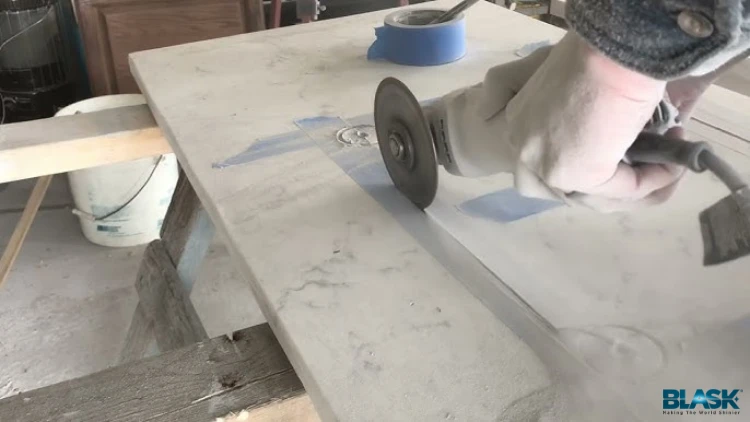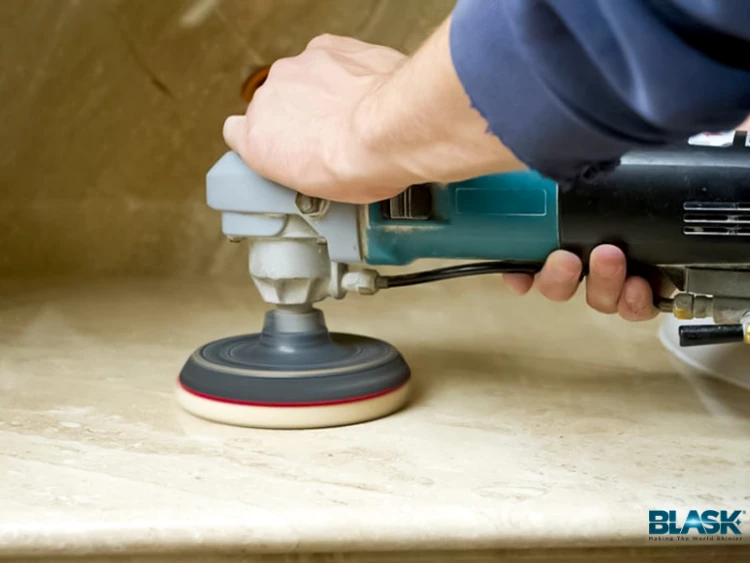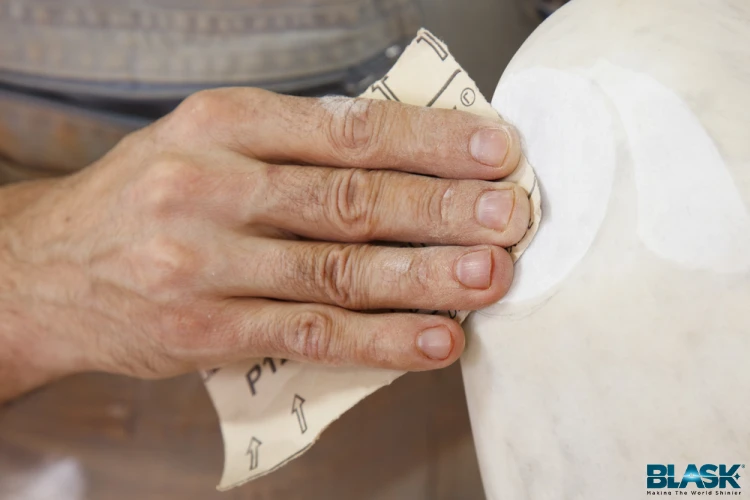The process of sanding marble is one of the important processes or finishes that aims to smooth the surface and completely get rid of the defects present in it. It is one of the matters that requires experience in order to be used with the utmost precision, and thus the desired result is achieved.
Blask Company is one of the companies specialized in the sanding process for every… Types of marble, so you find this process done in specific ways that are determined according to the type of marble used. If the goal of requesting marble sanding from the company is to eliminate the defects in the marble, such as cracks or fractures, the company will take care to choose a smooth finish, which is painted or finished first. This is to achieve the desired result in completely finishing and smoothing the marble surface.
The company takes good care in determining the final result of the marble surface to be sanded. The number of sandpaper grains must be taken into account. In this article, we will talk about marble sanding in addition to polishing materials for marble of all types, in addition to other important information related to marble sanding, so please follow along.
What are sandpaper grits?
The sanding process is based on the number of grains, so when dealing with a certified company that has full experience in sanding marble, you will find that they give a note to the customer about the number of sandpaper grains used in the process of scraping and smoothing the marble surface, when wanting to smooth the marble surface in a way that eliminates all the defects present in it. We advise you to deal with Blask Company, as it has excellent experience and has a long experience in dealing with all types of sanding and polishing, as it has marble and granite polishing materials of all types required.
Sandpaper grains are abrasive particles that adhere to paper supports of different sizes that are used depending on the problem facing the marble. Sanding the marble with the number of paper grains determines the extent of roughness or fineness of the abrasive particles.
Kitchen marble sander

Some companies depend on the method of polishing faded marble on several things, all of which relate to the shape and size of the grains, especially the degree of each grain, in proportion to the dull shape and the degree of dullness of the marble. If the kitchen marble in your home suffers from a dull color even though it is not… Old, this is very easy for an experienced company, as a fine powder is used to polish dull marble, whether it is regular marble or limestone.
In order for the process of sanding dull marble to be done well, you, as a customer, can choose or discuss the type of powder used in the process of sanding kitchen marble, and the company will give you general information about that and the degree of shine that the marble will eventually reach, and you do not have to worry about the safety of the type of sanding for marble. The kitchen, taking into account that it is a kitchen marble, will have utensils and foods on it.
You learn more about Marble polishing from this link
Natural marble sanding
Natural marble is a type characterized by its density and hardness. One of its most important characteristics is that it can be polished with ease, and it comes in many colors. The method of polishing natural marble for stairs and kitchen is done by Blask Company at the hands of skilled workers who are experienced in the marble polishing process in particular, so it cannot Worrying about the process at all.
Sanding natural marble is done after preparing the marble in general, meaning that if the marble has defects and burrs; The matter first requires getting rid of these protrusions through a complete scraping process, taking into account the preservation of the marble from any breakage or excessive scratches during this process. However, if the defects in the marble are large and in addition to the fact that the marble is very dirty; The process of polishing marble with a rocket is the ideal solution for your marble, and this is also determined by the company you will deal with.
Marble sanding method

The process of sanding marble is not as complicated as some people think, but at the same time sanding marble is a delicate process, and therefore requires concentration in order for the customer to get what he wants. There is more than one way in which marble sanding is done. For example, sanding with a rocket differs from regular sanding or which does not require sanding. Inserting the missile into it, and because most customers require regular or traditional marble sanding; We briefly mention the marble sanding method in the following lines:
- Use a cleaning liquid specifically designed for marble cleaning.
- After that, use a brush to completely get rid of any defects in the marble surface before the sanding process.
- Leave the cleaning paste on the marble for several minutes before disposing of it.
- After that, sanding material is applied, which is the last process to make the marble shiny.
- There are different methods used by companies, including Blask, to polish and sand marble as required, and determining this method depends on the condition of your marble.\
Read also about: wall sandpaper
How to polish dull marble

In some cases, polishing dull marble using household materials may be insufficient, especially if the surface has deep scratches or scuff marks. Here comes the role of sanding (marble sanding), as specialized sanding tools can be used to polish marble. Sanding supplies are available in multiple shapes at Blask Company, such as sand discs in different sizes to suit different polishing stages. Start with rough sanding to get rid of scratches and dull layers, then move to fine sanding to gradually smooth the surface and restore shine. After sanding, it is recommended to use a special marble polish to ensure the best results and long-lasting shine. This process must be carried out with caution or a professional must be called to ensure that the marble is not damaged. To know the details and prices of the products, you can contact us now.
Types of sandpaper
There are many types of sandpaper for marble, granite and various materials, but since we are talking about marble, the types of sandpaper used for it are:
- Sandpaper made of silicon carbide: It is the most commonly used sandpaper in metals and plastics. It can also be used in polishing marble as well, because it can withstand high heat.
- Aluminum oxide paper: multi-use and is used in fiberglass, wood and metal, especially sanding marble. This is because it is very durable and gives a wonderful touch.
- Garnet sandpaper: It is one of the most ideal types for finishing work and obtaining precise polishing of marble.
- Dry and wet paper: It is used with oil or water to apply the wet sanding process to parts of marble.
Sandpaper grit sizes
The sizes of marble sandpaper, or in general sanding grains, play a major role in the extent to which the sanding process is completed successfully. Without specifying the number of granules used in the process, you will not know what the overall shape will emerge from the polishing process or any other process that you want to obtain from sanding, so we explain in detail. The importance of sandpaper grit sizes:
- Coarse-grit sandpaper (40-60): It is very important and is ideal for getting rid of heavy materials found on marble or any metal. It helps in leveling the surface and getting rid of old paint, especially varnish.
- Medium grit sandpaper (80-120): Very important and suitable for any sanding process in general, and smoothing rough surfaces in particular.
- Fine-grit sandpaper (150-180): The main use of this number of grits is for finishing and light sanding. With this number of grits of paper, you can get rid of the smallest small defects in the marble.
- Finally, very fine-grit sandpaper (220+): This is the most important if you want to get a very smooth, polished marble texture.
All marble sanding operations are carried out at reasonable prices by Blask Company for all customers, so there is no need to worry about the price of this process. We have explained in the article that the number of sanding grains plays a major role in the degree of shine of the marble, whether it is natural or artificial marble, and based on it If you want to be sure of the result that you will get from sanding your home’s marble, ask first about the number of granules that will be used in polishing the marble and polishing it as desired. You can also inquire about the type of brush used in polishing the marble surface of the kitchen. All this and more about sanding marble will be answered. The company is very welcoming, just contact us.
Read more about: sandpaper for metal






